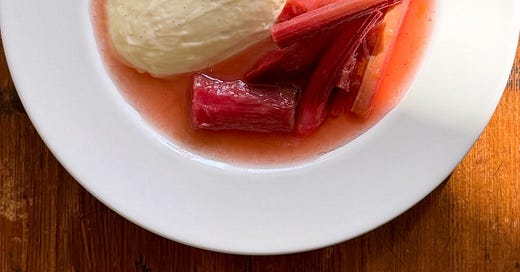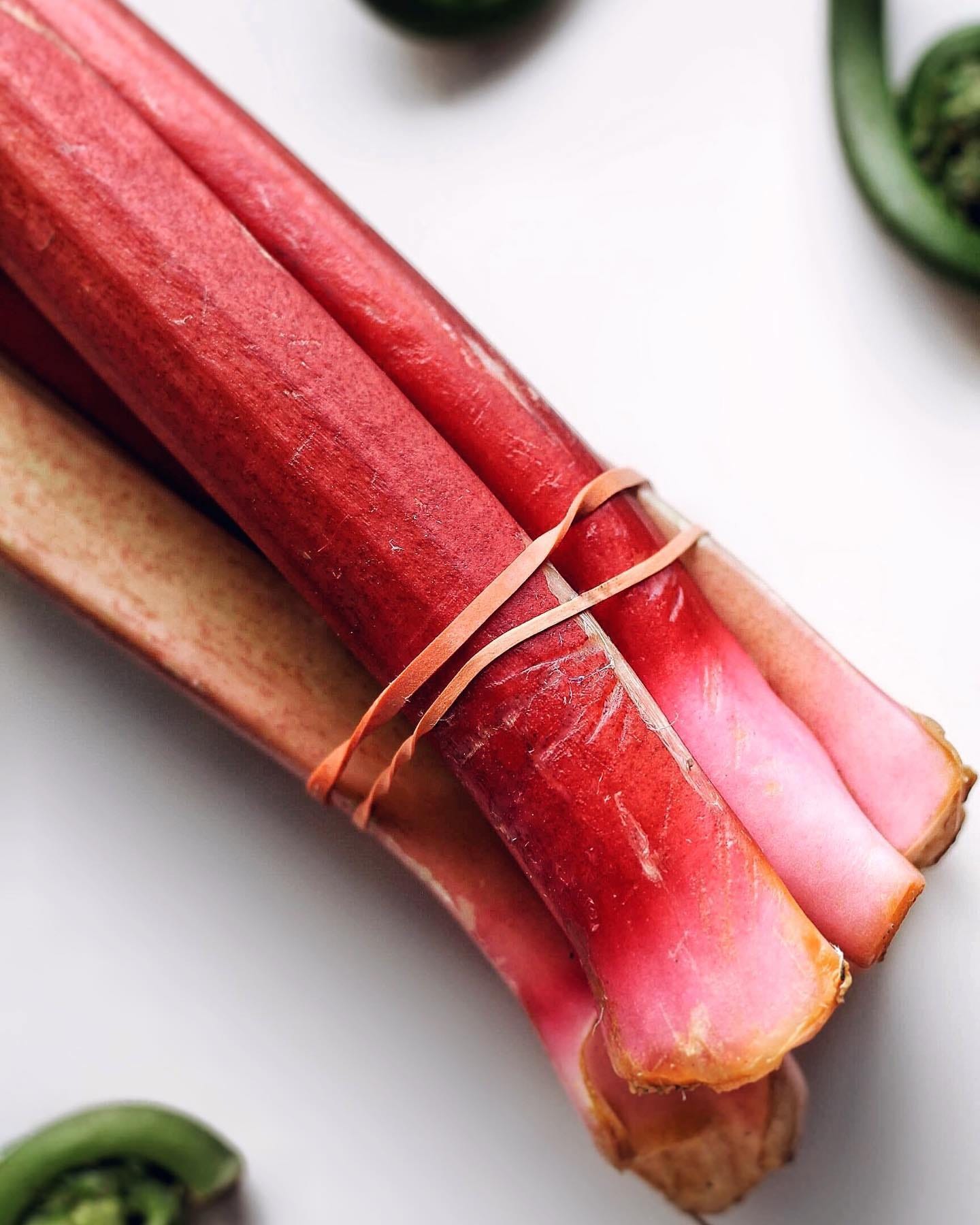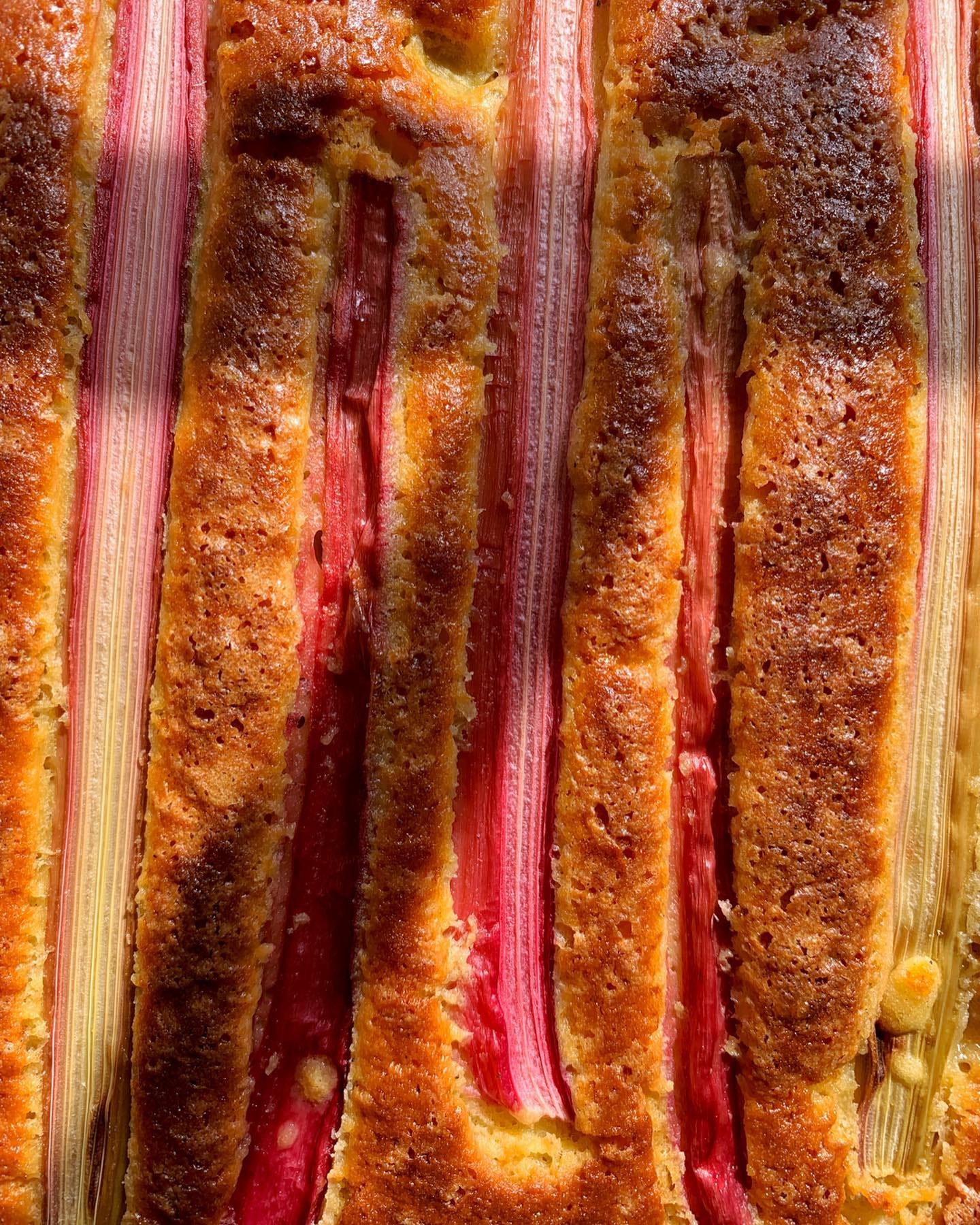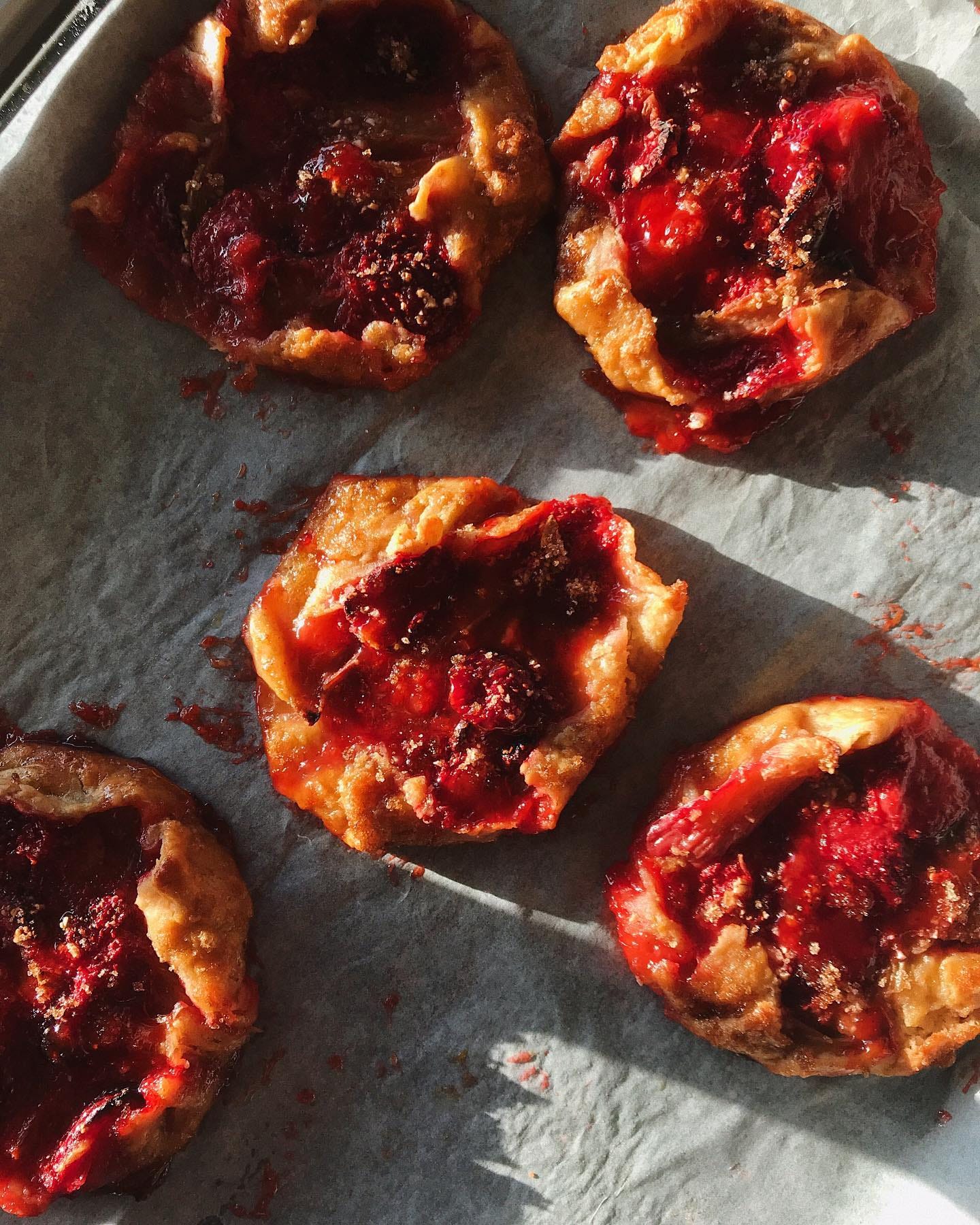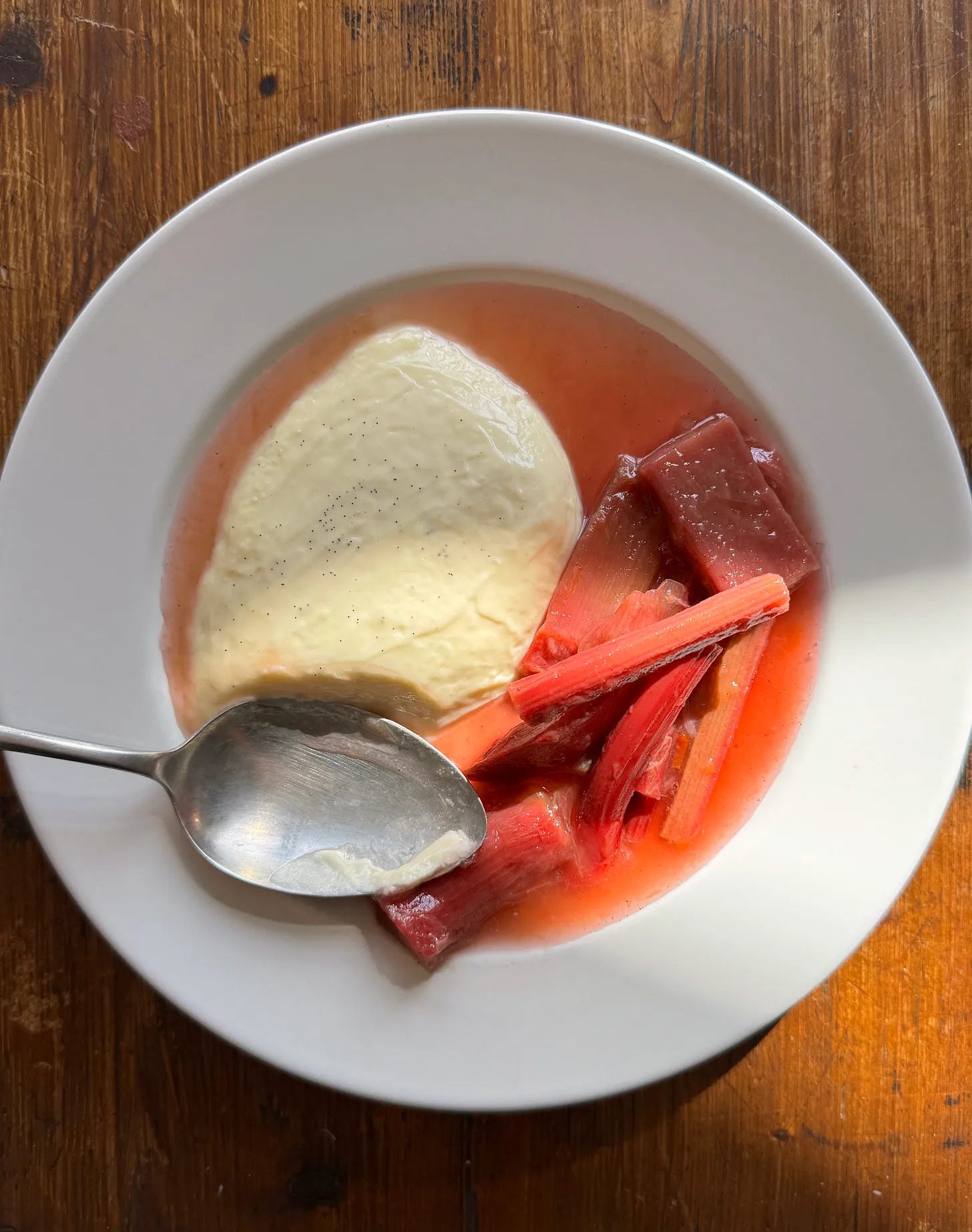👋+: Vanilla Poached Rhubarb & Cardamom Panna Cotta
gelatine-free panna cotta + how to eat more seasonally
Allô! 👋
Welcome (back) to the seasonal sundays supplement to the monthly good food at home newsletter, where every week we take a closer peek at produce at its peak — with a short introduction, at least one recipe, and a (sometimes related) cooking Q&A. Thank you for reading! If you haven’t subscribed yet, you can find all previous issues here. Annual subscriptions are currently discounted for a limited time.
Happy Sunday! I hope you’re all doing well. As the weather has been somewhat extreme and unseasonable lately, I also hope you’ve been keeping cool, shaded, and well-hydrated, wherever you may be.
I myself went paddle-boarding (!) for the first time this year just last weekend as it was almost 30°C (86°F) out, and I must say that it felt a tad dystopian to be doing something so summery so early in May (especially considering that I was floating on a hilltop lake way up in Scandinavian latitudes).
In spite of the unusual warmth this week, things are really starting to look not like summer but like late spring as rhubarb makes its grand entrance all across cool and moderate parts of the Northern Hemisphere (apologies to anyone living in warmer, drier climes).
RHUBARB SEASONALITY & ORIGIN
If you live in the UK you may have encountered very pink stalks of forced rhubarb (typically grown in West Yorkshire in an area known as the Rhubarb Triangle) back in late winter / early spring this year.
These are effectively the same species of rhubarb that are currently in season at the moment, typically from late spring to early summer: the main difference between the two is simply that forced rhubarb is grown under cover and in the dark so that its stalks become extra pink* and sweet, as well as being ready to harvest ahead of its natural season.
In today’s issue, however, we’re focusing on garden varieties of rhubarb, grown outdoors for the sun to kiss: this crimson vegetable is a perennial species native to cool, moderate parts of Asia and Europe (though it has also been naturalised in parts of North America and Oceania), as it requires cold winters and moist, moderate springs to thrive. That hasn’t stopped it from being popular elsewhere, however, and in fact its name refers to the legend that Ancient Romans loved it so much, they used to import it from barbarians living across the Volga (then called Rha) River: hence Rha barbarum, the latin terms which eventually gave us „rhabarber“ in German, « rhubarbe » in French, and “rhubarb” in English.
*no sunlight means no chlorophyll production — the same technique (also called blanching) is used for all sorts of vegetables, such as Belgian endives, leeks, white asparagus, and celery, generally to achieve a more delicate colour, tender texture, and sweeter flavour within a same plant variety.
RHUBARB FLAVOUR NOTES & PAIRINGS
You may be surprised to know that rhubarb is well suited to being eaten raw when freshly picked (just don’t eat the leaves), a bit like you could happily bite into a juicy stalk of just-harvested celery or asparagus. That said, unlike fresh celery and asparagus, you’ll likely want to dip your stalks into some sugar before digging in.
Rhubarb has a flavour reminiscent of green apple, sorrel, and unripe pear, with subtle hints of immature peach and even underripe plum. While this may sound nice in theory, what all of these tart flavour notes mean in practice is that rhubarb is, for most of us, too sour to enjoy without some gentle coaxing from the addition of heat and/or something sweet.
Common pairings include apples, pears, and peaches (usually preserved in some way), almonds, ginger, and cardamom, as well as co-seasonal strawberries, elderflower, and roses.
RHUBARB SHOPPING TIPS
In-season rhubarb is usually best when very fresh, so when shopping for stalks, look for ones that are firm with taut skins. Limp or dull stalks can still be enjoyable, though at that stage they are usually best suited for cooking down into compotes for chutneys and crumbles, porridges or pies.
Colour-wise, green stalks are usually just as nice as redder ones — the colour is more an indicator of how much (or little) sunlight the plant received during its growth than of taste — but pinker stalks do tend to be more mellow. If you look at the bottom of a stalk, on the opposite end of the leafy base, and see some brownness (oxidation) appearing, you’ll know that the stalks were picked a little while ago.
If plucking your own rhubarb from a garden, all you have to do is look for a good-looking stalk, grab it firmly by the base, and twist it out of the soil. Remove the brown papery bit from the bottom of the stalk, slash off the leaves (their high oxalic content is what makes them toxic to humans), rinse well, and enjoy.
RHUBARB TROUBLESHOOTING & STORAGE
Much like celery, when chopping up rhubarb you may notice some stringiness in your stalks. Those fibrous filaments are fine to eat, but can be stripped away with a knife if you prefer. Just note that you may lose some colour from the stalks in doing so.
Similarly, as with asparagus, sometimes the base of a rhubarb stalk can get quite tough and woody (especially as the season progresses into warmer and drier days). If faced with a partially tough stalk, simply cut off and compost its bottom and keep the tender tops to use as you otherwise would.
Lastly, as with celery and asparagus, rhubarb stores best when placed in a glass of fresh water and refrigerated with a produce bag draped over top. Trouble is, most of us don’t have fridge shelves tall enough to contain upright rhubarb! Your second best bet, then, is to keep them well-wrapped in a clean cloth, pop them into a plastic bag (bottom of the stalks tucked into the bottom of the bag), then place them in your crisper / vegetable drawer to use within a week or so, and up to three weeks.
•••
The inspiration for the recipe below comes from The Anchor & Hope gastro pub located in South London, whose brilliant team served a gorgeous grappa panna cotta with Yorkshire rhubarb on their menu back in 2023. I first dined at the restaurant in September of 2022 and would likely have licked every plate clean had I not been raised so well by my family, with whom I shared a memorable meal there.
I never did get the chance to try their poached rhubarb and panna cotta, but I have been thinking about it ever since. Seeing as dropping everything to travel to a far-off place for a taste of something delicious is outrageous (and time travel impossible), I decided that this year, I simply had try my hand at making my own. The result was even more swoonworthy than I could have imagined. So thank you to The Anchor & Hope for the inspiration. Below is my tribute to their tantalising dessert.
cardamom panna cotta & vanilla poached rhubarb 🥄
Most modern panna cotta recipes rely on gelatine to transform fresh, unwhipped cream and finely ground caster sugar into a dessert that holds its shape when cold and, while that may provide a fast solution for producing the decadent dairy dessert we all know and love, that isn’t the only way to arrive at a delicately smooth melt-in-the-mouth result.
Gelatine can quickly turn cream rubbery and stiff, and isn’t all that predictable from brand to brand or country to country (some people also say it smells of barnyard). Meanwhile, it turns out that, historically, panna cotta — “cooked cream” in Italian — likely wasn’t made with any gelatine at all and, instead, involved cooking the cream (as its name suggests) to gently coax the ingredients into a rich, ivory upstanding dessert.
Rhubarb in season makes a perfect complement to the meltingly cool cream, but you are of course welcome to serve the panna cotta with the accompaniment of your choice — likewise, the poached rhubarb will be just at home swirled through yoghurt or layered through a coffee cake. How you use the recipe below is up to you.
•••
INGREDIENTS
for 2 generous (or 4 conservative) portions
Keep reading with a 7-day free trial
Subscribe to good food at home to keep reading this post and get 7 days of free access to the full post archives.


